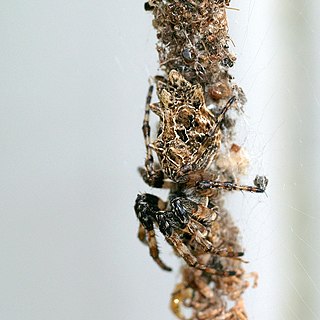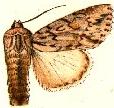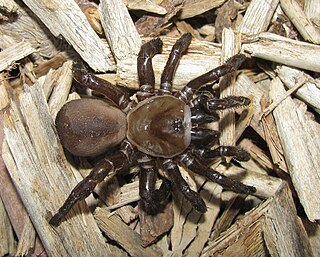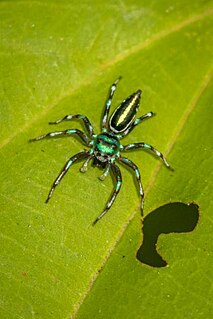
Jumping spiders or the Salticidae are a family of spiders. As of 2019, it contained over 600 described genera and over 6,000 described species, making it the largest family of spiders at 13% of all species. Jumping spiders have some of the best vision among arthropods and use it in courtship, hunting, and navigation. Although they normally move unobtrusively and fairly slowly, most species are capable of very agile jumps, notably when hunting, but sometimes in response to sudden threats or crossing long gaps. Both their book lungs and tracheal system are well-developed, and they use both systems. Jumping spiders are generally recognized by their eye pattern. All jumping spiders have four pairs of eyes, with the anterior median pair being particularly large.

Nursery web spiders (Pisauridae) is a family of araneomorph spiders first described by Eugène Simon in 1890. They resemble wolf spiders (Lycosidae) except for several key differences. Wolf spiders have two very prominent eyes in addition to the other six, while a nursery web spider's eyes are all about the same size. Additionally, female nursery web spiders carry their egg sacs with their jaws and pedipalps instead of attaching them to their spinnerets as wolf spiders do. When the eggs are about to hatch, a female spider builds a nursery "tent", places her egg sac inside, and stands guard outside, hence the family's common name. Like the wolf spiders, however, the nursery web spiders are roaming hunters that don't use webs for catching prey.

Ludwig Carl Christian Koch was a German entomologist and arachnologist.

Zoropsidae, also known as false wolf spiders for their physical similarity to wolf spiders, is a family of cribellate araneomorph spiders first described by Philipp Bertkau in 1882. They can be distinguished from wolf spiders by their two rows of eyes that are more equal in size than those of Lycosidae.

Nemesiidae, also known as funnel-web trapdoor spiders, is a family of mygalomorph spiders first described by Eugène Simon in 1889, and raised to family status in 1985. Before becoming its own family, it was considered part of "Dipluridae".

Cyclosa, also called trashline orbweavers, is a genus of orb-weaver spiders first described by Anton Menge in 1866. Widely distributed worldwide, spiders of the genus Cyclosa build relatively small orb webs with a web decoration. The web decoration in Cyclosa spiders is often linear and includes prey remains and other debris, which probably serve to camouflage the spider. The name "Cyclosa" comes from Greek 'to move in a circle', referring to how it spins its web.

Macrothele is a genus of mygalomorph spiders in the family Macrothelidae, and was first described by A. Ausserer in 1871. It is the only genus in the family Macrothelidae, and most species occur in Asia, from India to Japan, and Java, with four found in Africa, and two in Europe. The name is derived from Ancient Greek μακρός ("makro-"), meaning "big", and θηλή ("thele"), referring to the spinnerets.

Cosmophasis umbratica is a species of jumping spider found in South and Southeast Asia. These spiders are known for their brilliant, shiny ultraviolet light. They are members of the family Salticidae and the genus Cosmophasis. They are commonly spotted on green vegetation. C. umbratica shows extreme dimorphism when viewed under UV light: males reflect UV on all body parts that are displayed during intraspecific interaction, while females and juveniles do not reflect UV at all. It seems that C. umbratica uses this in sexual signaling. A similar phenomenon is found in some butterflies. For example, several species of Colias and Gonepteryx, both of the family Pieridae, also display sexual signaling.

Tarantulas comprise a group of large and often hairy spiders of the family Theraphosidae. Currently, 1,010 species have been identified. The term "tarantula" is usually used to describe members of the family Theraphosidae, although many other members of the same infraorder (Mygalomorphae) are commonly referred to as "tarantulas" or "false tarantulas". Some of the more common species have become popular in the exotic pet trade. Many New World species kept as pets have setae known as urticating hairs that can cause irritation to the skin, and in extreme cases, cause damage to the eyes.

Andropolia olorina is a moth in the family Noctuidae first described by Augustus Radcliffe Grote in 1876. It is found in California and Nevada.
Acroaspis is a genus of South Pacific orb-weaver spiders first described by Ferdinand Karsch in 1878.

Halonoproctidae is a family of mygalomorph spiders, split off from the family Ctenizidae in 2018. Species in the family are widely distributed in North and Central America, Australasia, Asia, southern Europe and North Africa. One species is recorded from Venezuela in South America. They are relatively large, sombrely coloured spiders, that live in burrows with some kind of trapdoor.
Padillothorus is a genus of jumping spiders in the family Salticidae containing the single species, Padillothorus elegans. It was first described by Jerzy Prószyński in 2018, and has only been found in Indonesia.

The Sitticini are a tribe of spiders in the family Salticidae. The tribe has been divided into two subtribes, Aillutticina, with five Neotropical genera, and Sitticina, with five genera from Eurasia and the Americas. One genus is unplaced within the tribe. The taxonomy of the tribe has been subject to considerable uncertainty. It was clarified in 2020.

Cosmophasis micarioides is a species of jumping spider found in Papua New Guinea, Australia and the Solomon Islands. The common name is sparkling northern jumping spider. When in motion, the male spider bobs its abdomen up and down reflecting sunlight that causes a characteristic sparkle.

Cosmophasis lami, also known as the Lami Beach northern jumping spider, is a species of jumping spider in the genus Cosmophasis, probably native to South East Asia and some pacific islands, and possibly introduced to Japan and Okinawa Islands by humans. It was first described by Berry, Beatty & Prószynski in 1997 and has one synonym, Cosmophasis squamata (Saaristo,2002) Both the female and the male have been described.

Cosmophasis gemmans is a species of jumping spider in the family Salticidae. Only the male has been described. The type specimen is deposited at the Museo Civico di Storia Naturale di Genova.

Cosmophasis micans, or the peacock jumping spider, or the green ant-mimicking jumping spider, is a species of jumping spider in the family Salticidae. It was first described as Amycus micans by L. Koch in 1880, and transferred to the genus Cosmophasis by Eugène Simon in 1901. It is indigenous to northern Queensland and the Torres Strait Islands.

Chrysillini is a tribe of jumping spider in the family Salticidae. In Maddison's 2015 revision of the family, the subfamily Heliophaninae was reclassified as a junior synonym of Chrysillini.















